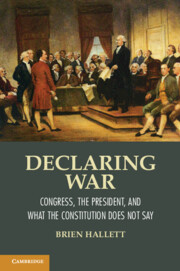Book contents
- Frontmatter
- Contents
- List of Figures
- Acknowledgments
- Prologue
- Miscellaneous Frontmatter
- 1 A Constitutional Tyranny and Presidential Dictatorship
- Part I What Is the History?
- 2 How the President Declares War
- 3 Why the Congress Ought Not Declare War
- 4 A Plan for Acquiescence
- Part II What Is a Declaration of War?
- Part III What Are the Solutions?
- Part IV What Is the Theory?
- Appendix I Five Congressional Declarations of War and One Appropriations Act
- Appendix II The Fœderative Powers in Parliamentary Governments
- References
- Index
2 - How the President Declares War
The War of 1812
Published online by Cambridge University Press: 05 November 2012
- Frontmatter
- Contents
- List of Figures
- Acknowledgments
- Prologue
- Miscellaneous Frontmatter
- 1 A Constitutional Tyranny and Presidential Dictatorship
- Part I What Is the History?
- 2 How the President Declares War
- 3 Why the Congress Ought Not Declare War
- 4 A Plan for Acquiescence
- Part II What Is a Declaration of War?
- Part III What Are the Solutions?
- Part IV What Is the Theory?
- Appendix I Five Congressional Declarations of War and One Appropriations Act
- Appendix II The Fœderative Powers in Parliamentary Governments
- References
- Index
Summary
The Congress shall have power … to declare war, grant letters of marque and reprisal, and make rules concerning captures on land and water.
(article I, section 8, clause 11)He [Pierce Butler of South Carolina] was for vesting the power [to make war] in the President, who will have all the requisite qualities, and will not make war but when the Nation will support it.
Friday, 17 August 1787Federal Convention, PhiladelphiaThe congressional declaration of 1812 is the first and most important example of how the president declares war. With it, President James Madison established the enduring precedents, procedures, and excuses. By 1812, it was well understood, if not widely accepted, that presidential decision making and leadership were essential elements for overcoming the organizational paralysis of the Congress. Since 1789, the size of the House had more than doubled, and its original committee-of-the-whole system had early on broken down in that chamber as a result of an ever-increasing workload. In its place, the modern standing-committee system slowly evolved by fits and starts. But war is not peace. Were presidential decision making and leadership also necessary for the declaring of war? Might it be possible for the Congress to decide the question of war or peace independently of the president? If so, then the hopes of the Federal Convention would be realized. If not, then the American republic would differ little from all the tyrannous kingdoms and empires of history, at least with respect to war.
With the shrewd assistance of the newly elected Speaker, Henry Clay, President Madison was able to answer the question. As in peace, so in war, the congressional power to declare war could not be exercised without strong and insistent presidential leadership and decision making. To overcome congressional paralysis on this issue as well as all other issues, the power to declare war would be exercised only after a presidential decision and only with presidential leadership. Not incidentally, the newly evolving standing-committee system in the House greatly facilitated President Madison’s task.
- Type
- Chapter
- Information
- Declaring WarCongress, the President, and What the Constitution Does Not Say, pp. 11 - 41Publisher: Cambridge University PressPrint publication year: 2012

